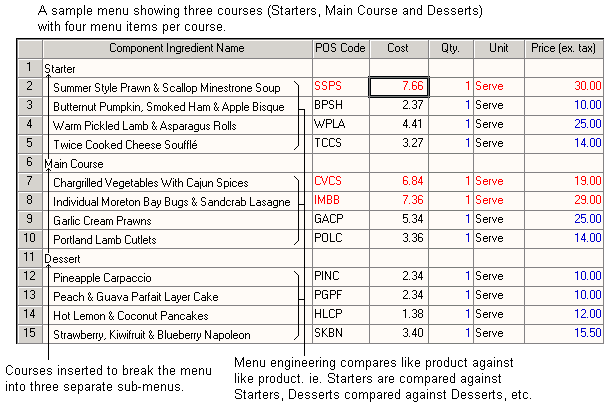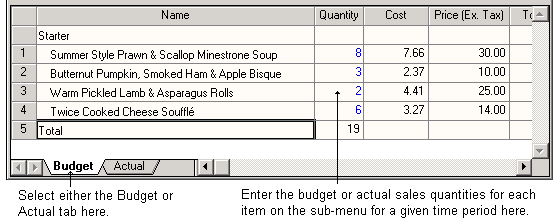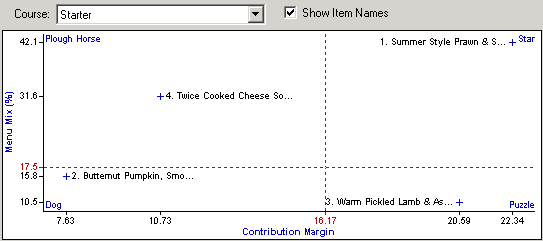If you are unfamiliar with the concept of Menu Engineering, please read the topic titled 'What is Menu Engineering?' before reading this topic.
To get the most out of Resort Restaurant's menu engineering you should set up budget figures to analyze the products on the menu before actually 'going public' with a new menu. After the menu has been on-sale for a while, you can enter the actual sales figures to see how individual items on the menu are performing compared to your original budget.
The rest of this topic discusses the order in which you perform various tasks to get the best results.
Build a menu
You start by building a menu and inserting all of the retail products for sale on the menu. (All menu creation and modification is performed in Resort Restaurant's Menu Form.)
Remember to include courses to break the menu down into sub-menus (i.e. starters, main courses, desserts, etc.). If you don't structure your menu with courses, then the menu engineering will simply not work and you will be wasting your time. See the following screenshot.

Enter budget sales figures
Before 'going public' with a new menu, enter the quantities of each dish that you expect to sell for a given time period (typically one day, one week, or one month) into the Engineering (Table), or the Engineering (Graph) page of the Menu Form. Make sure you click the 'budget' tab at the bottom of the grid selected before doing this.
The following partial screenshot shows one of the tables (grids) into which you can enter menu engineering sales figures. This is from the Engineering (Graph) page of the Menu Form, but you can just as easily enter sales figures into the Engineering (Table) page of the Menu Form.

Where do these budget sales figures come from? Your experience. When designing a menu, you don't just select items out of the air, you use your experience and knowledge of your target customer base to choose appropriate dishes to list on the menu. You will also need to rely on this experience to determine what budget sales figures to enter into the menu engineering tables. You should have an approximate idea from past experience of what sort of sales to expect from the items on your menu.
Interpreting the results
After entering budget details, you should review the menu engineering results to see how each item is expected to perform. The program will use the calculated recipe costs along with the budget sales figures to display the performance of each of the items on your menu. In particular, the Engineering (Graph) page will give you an 'at a glance' view of the expected sales performance of the various items on a selected sub-menu.
The following screenshot shows the menu engineering graph for a fairly simple sub-menu with four items on the sub-menu. Coincidentally, each menu item has a different menu engineering ranking (star, puzzle, etc.). These rankings can be seen from each item's position on the graph below. For instance, the 'Summer Style Prawn & Scallop Minestrone Soup' is in the top right corner and is ranked a Star.

What can we tell from this graph? The main things to consider are the individual menu engineering rankings of the items on the menu.
•The 'Summer Style Prawns' is ranked as a Star and is fine as it is. It's making good profit (High CM) and is popular (High MM).
•The 'Warm Pickled Lamb' ranks as a Puzzle. That is, it's profitable (CM is high), but isn't very popular with the customers.
•The 'Twice Cooked Cheese Souffle' ranks as a Plough Horse. It's popular with your customers (MM is high), but doesn't make much profit compared to the Prawn and Lamb dishes (CM is low). You may consider pushing the price up a little higher, or reducing the portion size slightly, thereby increasing the CM, but this will most likely happen at the expense of some of the item's popularity. Do you increase the price, lower the portion size, or just leave it as it is? This is a judgment call for you to make.
•The 'Butternut Pumpkin' ranks as a Dog. It doesn't make you much money (low CM) and the customers don't like it much (MM is low). Dogs are candidates for deletion from a menu. There are occasions where there are dog items that MUST stay on a menu, but in most cases you should consider removing them from the menu or replacing them with other items.
NOTE: For more detailed information on menu engineering graphs, please see the topic titled 'How do I interpret a menu engineering graph?' Resort Restaurant also lists a number of calculated items in the menu engineering tables (grids). These are seen on the Engineering (Table) page and Engineering (Graph) pages of the Menu Form. See those topics for details on what calculated values are displayed.
You should adjust menu item prices, portion sizes, and expected sales quantities to achieve the desired results at the design stage. At each change, the program will recalculate all of the menu engineering details and redisplay them interactively.
If you need to discuss a menu's design with your colleagues, you can print off a Menu Engineering 2 (Budget) report which will list all of the menu engineering details (along with the graphs) for the selected menu.
Up and running
Once you have introduced your new menu to your customers and have a few days trading figures, you can enter those actual sales figures into the menu engineering table. As for budget menu engineering, Resort Restaurant will calculate the menu engineering results using your actual figures and display those results in both graphic and tabular form.
As for menu analysis at the budget stage, you should review the rankings for each menu item and make appropriate adjustments to the menu (adjust prices, adjust portions sizes or drop items from the menu). You can also compare the expected (budget) results against the actual results to see if the menu is performing to expectations.
Putting it all together
To reiterate, here's the procedure...
| 1. | Create your new menu. |
| 2. | Enter budget sales figures. |
| 3. | Check the results and go to step 2 to make any necessary adjustments. |
4. Unleash your new menu on the undeserving public.
| 5. | Enter the actual sales figures. |
| 6. | Review the menu engineering results and adjust product prices and/or portion sizes. |
| 7. | Repeat from step 5 as long as the menu is active. |
NOTE 1: A couple of points to keep in mind when preparing recipes and ingredients for menu engineering.
•Resort Restaurant only lets you insert recipes or ingredients which have been flagged as 'retail products' into menus. For a recipe or an ingredient to qualify for insertion in a menu, its 'Retail' flag must be set. See the topic on Ingredients & Costs Page under Recipe Form and/or the General Details Page of the Ingredient Form for further guidance.
•Retail recipes should be set up with a production unit like 'Serve', 'Cover', or 'Portion'. Resort Restaurant menu engineering assumes that this basic style of unit has been used in the recipe creation process. The program uses the calculated cost per production unit in the menu engineering table, hence a cost/gram or pound doesn't make much sense. A recipe's production unit is setup in the Recipe & Costings Tab in the Recipe Form.